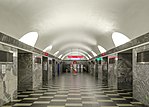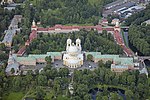Yesenin Monument
Monuments and memorials in Saint PetersburgRussia stubsSculpture stubsVandalized works of art in Russia

The Yesenin Monument (Russian: памятник Есенину) is a sculpture in the Tauride Garden in the centre of Saint Petersburg. Made of white marble and set on a small pedestal, it represents the Russian poet Sergei Yesenin seated in a thoughtful pose. The monument has been subjected to several attacks by vandals. It has been painted, and had its nose and fingers removed. After it was damaged a fourth time in 2009, the decision was made to make it less accessible, although it remains in its original location.
Excerpt from the Wikipedia article Yesenin Monument (License: CC BY-SA 3.0, Authors, Images).Yesenin Monument
Kirochnaya Street, Saint Petersburg Peski (округ Смольнинское)
Geographical coordinates (GPS) Address Nearby Places Show on map
Geographical coordinates (GPS)
| Latitude | Longitude |
|---|---|
| N 59.944444444444 ° | E 30.369166666667 ° |
Address
С. А. Есенин
Kirochnaya Street
191015 Saint Petersburg, Peski (округ Смольнинское)
Saint Petersburg, Russia
Open on Google Maps











